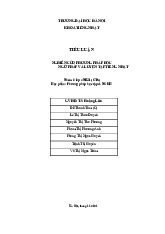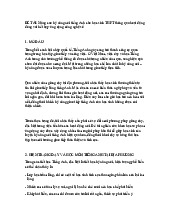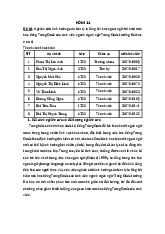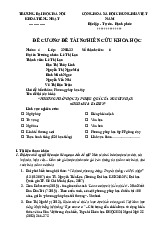







Preview text:
Impact of less sleep on learning concentration in class
S. H. Afifah1, A. W. Kusuma2, A. P. Putra3, G. R. Putri4 syifahnff@gmail.com1
Department of Telecommunication Engineering, Telkom University, Indonesia1, 2, 3, 4 Abstract
This study aims to obtain a description of the effects of sleep deprivation of students
on learning concentration. The description includes four things, namely: frequency of
sleepiness, hours of sleep, reasons for lack of sleep, and the level of concentration of
learning. The method used in this research is qualitative method. Data was collected
through a survey of 60 students. The results of this study indicate that the frequency
of sleepiness of students in class is very high, very little hours of sleep, the reason for
lack of sleep is because of staying up late, studying, and assignments. Meanwhile, the
average student experiences a low concentration of learning.
Keywords: learning concentration, insomnia, parasomnia, sleep 1. INTRODUCTION
Daily activities often deplete stamina so that the body experiences fatigue. Body
stamina can return to be optimal after we rest or sleep. Enough or insufficient sleep
can greatly influence human concentration. When a person has difficulty falling asleep,
it usually has a bad impact on the activities they lead. The definition of sleep according
to experts is defined as a subconscious state in which a person can still be awakened
by giving sensory stimuli or by other stimuli (Guyton and Hall, 2008).
Sleep is a state when the body is in a regular state, and in a state of silence,
recurrence, and an increase in external response in an unconscious state. Sleep is the
state of a person under his consciousness and if given sensory stimuli or other stimuli
that person can be awakened (Guyton and Hall, 2008). Sleep is an activity carried out
repeatedly that changes the conscious status or awareness within a certain time (Potter, 2005).
Serious sleep difficulties are usually experienced by some people and experience
complications due to lack of sleep such as declining health, drug dependence, etc. In
the aspect of sleep needs, not only looking at the factors of sleep hours, but we also
have to look at factors of the quality of one's sleep. A good quality of sleep can be seen
when someone shows no signs that he has problems in his sleep. Changes in sleep
patterns usually occur because of the demands of daily activities. Usually, students
sleep too late because of the demands of work or study because the exam will be held.
Students who have sleep deprivation problems usually look sleepy while in the
classroom. The drowsiness was also often complained by students. Every night a
person experiences two different types of sleep and alternates with each other: Rapid-
Eye Movement (REM) sleep and Non-Rapid-Eye Movement (NREM) sleep. Changes
in sleep levels affect the quality of one's sleep (Sudaryat, Nurhadi, Rahma, & Mayasari,
2019). Human sleep patterns are influenced by the lifestyle of humans themselves,
including the human social relationships, stress levels that refer to insomnia can
interfere with human sleep patterns. Human age is one of the factors that determine
how long sleep is needed. Older or more mature, the less time needed to sleep (Asmadi, 2008).
Learning concentration according to Nugroho (2012) is concentration of
thought, a situation when the situation is calm, peaceful, comfortable, individual
attention to a learning that is being faced. Learning concentration according to
Nugroho (2012) is concentration of thought, a state when the situation is calm,
peaceful, comfortable, individual attention to a learning that is being faced. This
concentration of learning also influences how the brain works. The higher the
concentration of ability, the higher the person's comprehension (Rahma & Nurhadi, 2018a, 2018b). METHOD
The method in this study uses qualitative methods. Data was collected through
a questionnaire using Google Forms. Sources of data come from students at Telkom
University. There were 60 respondents in this study consisting of 30 men and 30
women. Data processed with descriptive statistics. Then described using graphs and tables.
RESULTS AND DISCUSSIONS
Frequency of Drowsiness
This section discusses the frequency of Telkom University students who are
sleepy when attending lecture material on campus. After doing the survey, we get data like the chart below.
Frequency of Drowsiness in College 5 , 9 41 , 2 52 , 9 Always Often Sometimes
Figure 1. Frequency of Drowsiness when You Follow in Lecture
It can be seen from the data above that there are 5.9% of Telkom University students
who are always sleepy in learning course material, there are 41.2% of Telkom
University students who are often sleepy in learning course material , and there are
52.9% of Telkom University students who are sometimes sleepy in learning course material
Students’ Bedtime Duration
This section discusses the hours of sleep of Telkom University students at night.
After doing the survey, we get data like the chart below.
Students' Bedtime Duration 11 , 8 23 , 5 29 , 4 35 , 3 <5 Hours 5-6 Hours 6-7 Hours >7 Hours
Figure 2. Students’ Bedtime Duration
It can be seen from the data above that there are 23.5% of Telkom University
having sleep schedules of less than 5 hours which are indicated to be poor, there are
35.3% of Telkom University students having sleep schedules as many as 5 to 6 hours
indicated lack of sleep, there were 29.4% of Telkom University students having sleep
schedules of 6 to 7 hours which were indicated to be quite good, and there were 11.8%
of Telkom University students in TT- class 43-10 have a sleep schedule of more than
7 hours which is indicated to be very good.
Reasons for Sleep Deprivation
This section discusses why Telkom University students have poor sleep quality. After
doing the survey, we get data like the chart below. Reasons for Sleep Deprivation 11 , 8 35 , 3 52 , 9 Task Staying up late Studying
Figure 3. Reasons for Sleep Deprivation
It can be seen from the data above that there are 52.9% of Telkom University
students who reason that they are lacking sleep because they are working late into the
night to pursue a period of time, there are 35.3% of Telkom University students lack of
sleep because they just want to stay up late just like playing games, watching movies,
and listening to music, there are 11.8% of Telkom University students reasoning that
they are sleep deprived because at night it is used to study, repeat the material that
has been taught, and memorize material for the test.
Students Concentration Level
In this section, we discuss how to concentrate when studying college if the sleep
quality of Telkom University students is lacking. After doing the survey, we get data like the chart below. Concentration Level 11 , 8 29 , 4 58 , 8 Low Enough High
Figure 4. Students Concentration Level
It can be seen from the data above that there are 29.4% of Telkom University
students who lack concentration and cannot receive learning clearly when they lack
sleep, there are 58.8% of Telkom University students who lack sleep but can receive
learning material even if it is only sufficient, and there 11.8% of Telkom University
students are sleep deprived but have full concentration and are able to receive learning material clearly.
Sleep Problems Faced by Students
From all the data we get, a lot of Telkom University students have poor sleeping
habits so that it can influence concentration in understanding lecture learning material.
Concentration is the concentration of the self and the function of the soul on an object,
paying attention to the seriousness of what is the object of concentration without regard
to things that can interfere with that attention. Concentration in learning is needed so
that all learning material can be entered and digested by the brain so that we can
understand and remember the material well.
A person's level of concentration is also influenced by sleep patterns. The
majority of Telkom University students claim to have difficulty concentrating when
learning material due to staying up late at night. In addition to difficulty concentrating,
poor sleep patterns also cause insomnia and parasomnia. Insomnia is a symptom
when a person has difficulty sleeping. This includes difficulty falling asleep, often
waking up at night and waking up too early which causes during the daytime conditions
are not fresh due to lack of sleep. Parasomnia is a sleep disorder when the individual
can experience events such as sleepwalking, sleep talking, and so on.
Sleep patterns and concentration have a strong relationship. Good sleep patterns
have a period of more than 7 hours. Many Telkom University students ignore good
sleep patterns. This is really unfortunate, if someone has a lack of sleep patterns it will
have an impact on health. Health in individuals can be reduced so that there is a
decrease in concentration. For example, if a student has a lack of sleep patterns then
health is reduced, resulting in a decrease in student concentration, if the concentration
of students decreases, students cannot receive and digest learning material well which
can have an impact on student achievement. to maintain the concentration of learning
needs to be maintained sleep patterns. Enough sleep makes a high concentration of
learning and more focused on learning, so students can digest the knowledge gained and excel in their lectures. CONCLUSIONS
Based on the results of data collection that has been done through a form or survey
about the impact of sleep deprivation on the learning process of students of Telkom
University. The intensity and duration of sleep tends to be 5-6 hours to sleep with the
excuse of doing work late into the night for the sake of pursuing a period of time,
playing games, watching movies, listening to music, repeating material that has been
taught, and memorizing the material for the exam. If you sleep less than 7 hours,
students and students have difficulty concentrating in following learning, can also
cause insomnia and parasomnia. Sleep should be done more than 7 hours a day so
that students and students can concentrate on participating in learning. So, a good
sleep pattern for students and college students is to sleep in a relatively permanent
time and have a schedule to start sleeping and to wake up in a day that is done regularly. REFERENCES
Asmadi. (2008). Teknik Prosedural Keperawatan: Konsep dan Aplikasi Kebutuhan
Dasar Klien. Jakarta: Penerbit Salemba.
Guyton dan Hall. (2008). Aktivitas Otak Tidur, Gelombang Otak, Epilepsi, Psikosis:
Buku Ajar Fisiologi Kedokteran. Jakarta: EGC.
Potter, Perry. (2005). Fundamental Keperawatan. Jakarta: EGC.
Rahma, R., & Nurhadi, J. (2018a). Can Power Spectral Density (PSD) be used to
Measure Reading Concentration? In Proceedings of the Tenth Conference on
Applied Linguistics and the Second English Language Teaching and Technology
Conference in collaboration with the First International Conference on Language,
Literature, Culture, and Education (CONAPLIN and ICOLLITE 2 (pp. 450–453).
Bandung: ScitePress. https://doi.org/10.5220/0007169004500453
Rahma, R., & Nurhadi, J. (2018b). Measurement of concentration duration on reading
activity: EEG analysis with OpenBCI Ganglion Board. Pedagogy EJournal, 1(32).
https://doi.org/http://dx.doi.org/10.2139/
Sudaryat, Y., Nurhadi, J., Rahma, R., & Mayasari, M. (2019). Hypnotic Direct and
Indirect Suggestions for Improving the Efficiency and Depth of Sleep: An EEG
Activity Signal Processing in Various Sleep Stages. Journal of Physics:
Conference Series, 1179. https://doi.org/10.1088/1742-6596/1179/1/012146



